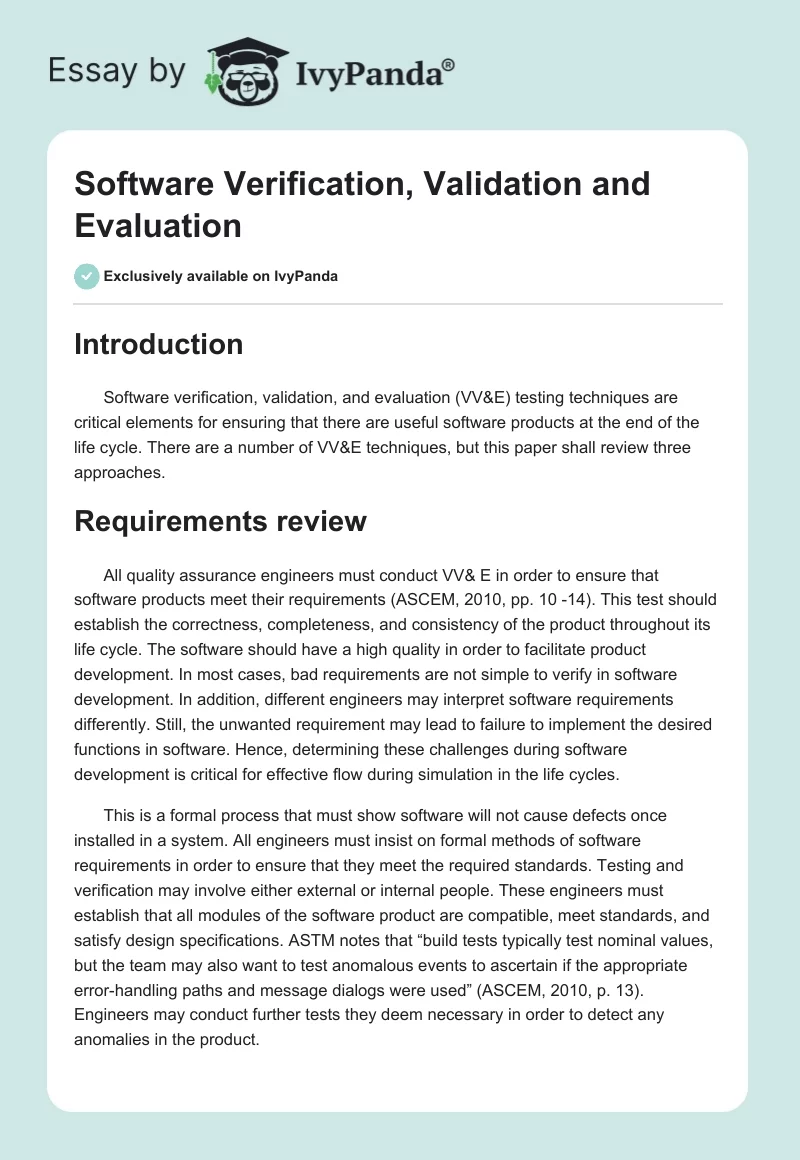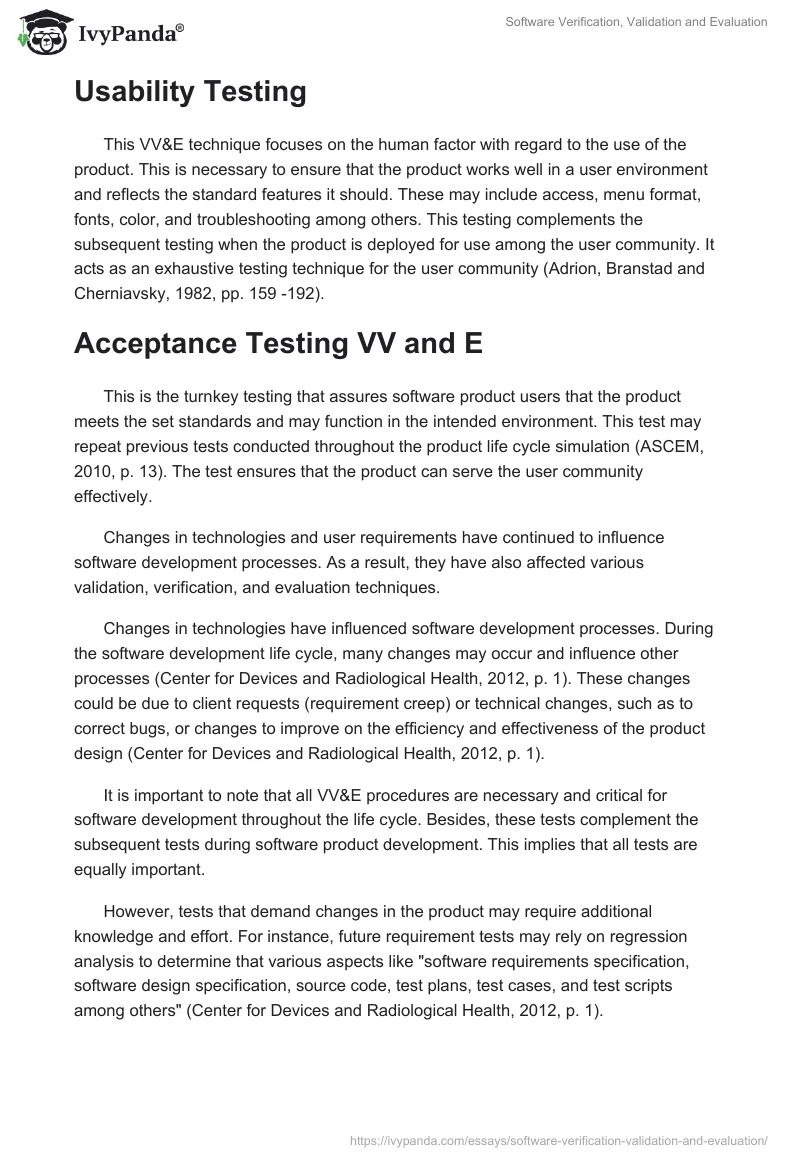Introduction
Software verification, validation, and evaluation (VV&E) testing techniques are critical elements for ensuring that there are useful software products at the end of the life cycle. There are a number of VV&E techniques, but this paper shall review three approaches.
Requirements review
All quality assurance engineers must conduct VV& E in order to ensure that software products meet their requirements (ASCEM, 2010, pp. 10 -14). This test should establish the correctness, completeness, and consistency of the product throughout its life cycle. The software should have a high quality in order to facilitate product development. In most cases, bad requirements are not simple to verify in software development. In addition, different engineers may interpret software requirements differently. Still, the unwanted requirement may lead to failure to implement the desired functions in software. Hence, determining these challenges during software development is critical for effective flow during simulation in the life cycles.
This is a formal process that must show software will not cause defects once installed in a system. All engineers must insist on formal methods of software requirements in order to ensure that they meet the required standards. Testing and verification may involve either external or internal people. These engineers must establish that all modules of the software product are compatible, meet standards, and satisfy design specifications. ASTM notes that “build tests typically test nominal values, but the team may also want to test anomalous events to ascertain if the appropriate error-handling paths and message dialogs were used” (ASCEM, 2010, p. 13). Engineers may conduct further tests they deem necessary in order to detect any anomalies in the product.
Usability Testing
This VV&E technique focuses on the human factor with regard to the use of the product. This is necessary to ensure that the product works well in a user environment and reflects the standard features it should. These may include access, menu format, fonts, color, and troubleshooting among others. This testing complements the subsequent testing when the product is deployed for use among the user community. It acts as an exhaustive testing technique for the user community (Adrion, Branstad and Cherniavsky, 1982, pp. 159 -192).
Acceptance Testing VV and E
This is the turnkey testing that assures software product users that the product meets the set standards and may function in the intended environment. This test may repeat previous tests conducted throughout the product life cycle simulation (ASCEM, 2010, p. 13). The test ensures that the product can serve the user community effectively.
Changes in technologies and user requirements have continued to influence software development processes. As a result, they have also affected various validation, verification, and evaluation techniques.
Changes in technologies have influenced software development processes. During the software development life cycle, many changes may occur and influence other processes (Center for Devices and Radiological Health, 2012, p. 1). These changes could be due to client requests (requirement creep) or technical changes, such as to correct bugs, or changes to improve on the efficiency and effectiveness of the product design (Center for Devices and Radiological Health, 2012, p. 1).
It is important to note that all VV&E procedures are necessary and critical for software development throughout the life cycle. Besides, these tests complement the subsequent tests during software product development. This implies that all tests are equally important.
However, tests that demand changes in the product may require additional knowledge and effort. For instance, future requirement tests may rely on regression analysis to determine that various aspects like “software requirements specification, software design specification, source code, test plans, test cases, and test scripts among others” (Center for Devices and Radiological Health, 2012, p. 1).
The exponential growth in software development has presented considerable challenges to software testing. Hence, there is a need to reinvent software testing and validation in order to assure and improve product quality. One must recognize that the development of new software products has expanded beyond the normal capacity. Hence, one must consider new techniques in order to handle emerging software products for new technologies like cloud computing, smart devices, user security and security, social networking, changes in the content, and a networked environment. The VV&E techniques must strive to deliver the best testing experiences on scale and schedule during software development. New testing methods will emerge. However, they must co-exist with contemporary testing and evaluation methods.
Software validation principles differ from one stage of development to the next one. Future software validation, verification, and evaluation techniques will provide flexibility for developers and users to test their products at any stage. However, they must have the ultimate responsibility of ensuring that the software product has undergone all required validation processes.
All future testing, verification, and validation techniques must ensure that software products undergo all procedures. The life cycle models provide different activities for conducting different tasks on software. They would provide a framework for “controlling, guiding, and monitoring software development processes” (Center for Devices and Radiological Health, 2012, p. 1).
It is important for usability, requirement, and acceptability testing to account for the product and its intended use. Thus, the processes will focus on the most critical aspects of software development. All future processes must also rely on defined software specification requirement documents during testing because validation cannot occur without predefined and documented elements of software requirements.
References
Adrion, W., Branstad, M., and Cherniavsky, J. (1982). Validation, Verification, and Testing of Computer Software. Computing Surveys, 14(2), 159-192.
ASCEM. (2010). ASCEM Software Verification & Validation Plan – Basic Phase. Web.
Center for Devices and Radiological Health. (2012). General Principles of Software Validation; Final Guidance for Industry and FDA Staff. Web.


